Table of Contents
Introduction
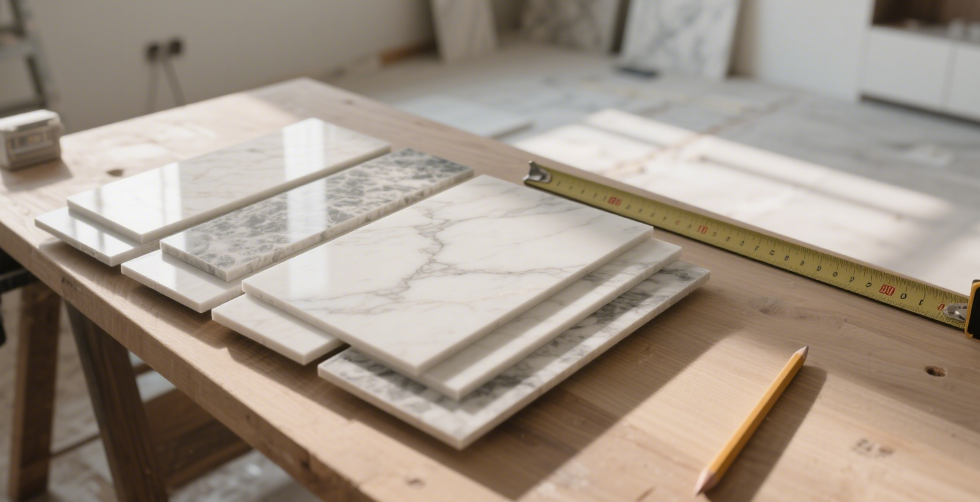
In contemporary commercial and residential projects, finishes that combine aesthetics, durability, and affordability are in high demand. UV marble sheet has emerged as a popular engineered surface that delivers marble-like visuals with lower cost and simpler installation compared with natural stone. For architects, interior contractors, furniture manufacturers, and procurement managers, understanding practical, cost-saving applications for this material can unlock significant project savings while maintaining design intent.
This article examines four practical uses of UV marble sheet that deliver measurable cost benefits: wall cladding, kitchen and bathroom cabinetry, commercial furniture and fixtures, and flooring in select applications. Each use case includes technical considerations, installation methods, maintenance tips, lifecycle cost comparisons, and procurement strategies aimed at B2B buyers. The article also offers a mid-article comparative table for quick reference, implementation roadmaps, sustainability notes, and an extended FAQ to address common procurement and performance questions. Throughout the piece, the keyword UV Marble Sheet is used strategically and sparingly to stay well under a 2% density while ensuring search relevance.
Why UV Marble Sheet Is Cost-Effective for Projects
Before diving into the four uses, it helps to understand why UV-coated engineered marble surfaces provide cost advantages:
- Lower material cost vs natural stone: Engineered sheets are manufactured using resin, mineral powder, and high-definition printing or UV-cured coatings to replicate marble patterns. Production economies and consistent dimensions generally make them less expensive per square meter than quarried slabs.
- Reduced cutting and fabrication expense: Sheets are typically produced in standardized widths and lengths, reducing complex cutting and on-site shaping costs. CNC and shearing equipment handle sheets efficiently.
- Faster installation times: Lightweight panels enable faster handling and simpler mounting systems, which lowers labor hours and overall installation budget.
- Lower maintenance and repair costs: Durable UV-cured surfaces resist staining and scratching better than some natural stones, reducing long-term cleaning and maintenance expenditures.
- Waste reduction: Uniform sheet sizes and optimized nesting reduce offcuts and scrap, keeping material loss low.
Understanding these baseline advantages helps explain why UV marble sheet can deliver savings at multiple stages of a project lifecycle: procurement, fabrication, installation, and operation.
Use 1: UV Marble Sheet for Wall Cladding — High-Impact, Low-Cost Facades
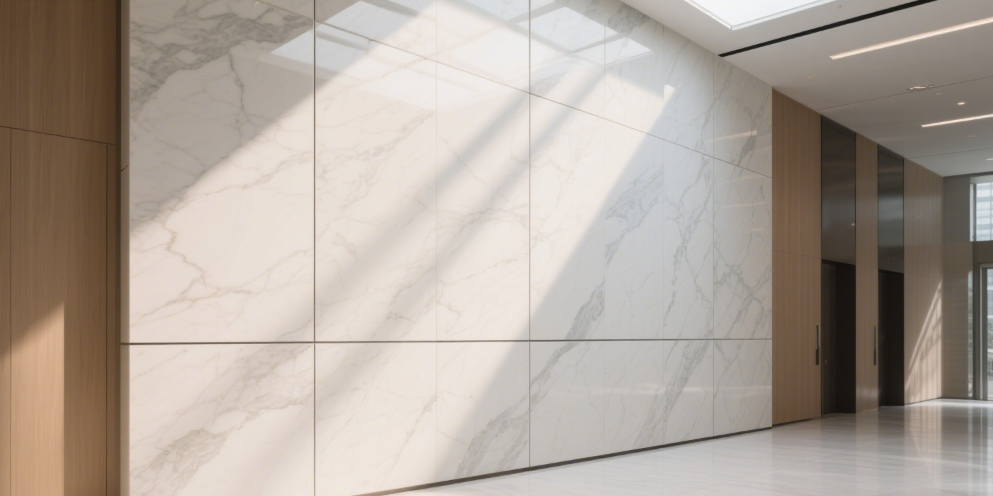
Why choose UV marble sheet for wall cladding?
Wall cladding is a high-visibility application where aesthetics matter most. Exterior and interior feature walls that mimic natural marble can be expensive when using quarried stone because of material cost, framing requirements, weight handling, and precision installation. For interior wall cladding and many sheltered exterior applications, UV marble sheet offers a visually comparable finish at a fraction of the cost and weight.
Cost-saving mechanisms for cladding
- Lightweight construction reduces structural framing needs. Natural stone often requires reinforced support or steel frameworks. Engineered sheets weigh much less, enabling simpler substrates and sometimes eliminating expensive reinforcement.
- Simpler anchoring systems. Tongue-and-groove, concealed clip systems, or adhesive-backed installation reduce labor time compared with heavy stone anchors.
- Faster on-site turnaround reduces labor costs. Panels are handled quickly by two-person teams using suction lifts or simple clamps, decreasing project man-hours.
- Lower transportation costs. Flat-packed, lighter sheets cost less to move from factory to site, especially for high-rise or distant projects.
Technical considerations for cladding installations
- Substrate preparation: Walls must be flat, clean, and structurally suitable for panel attachment. Backer boards, cementitious underlays, or framed studs are common substrates.
- Joining and seams: For premium aesthetics, plan for minimal visible seams, typically achieved with precise panel sizing and tight-tolerance fabrication. Sealants can provide moisture control while maintaining appearance.
- Fire and code compliance: Verify the specific fire rating and surface class required for interior or exterior use in your jurisdiction. Some UV-coated products meet interior flame spread limits but may require non-combustible backings or fire barriers for exterior façades.
- Moisture management: In wet areas, a waterproof membrane behind the panel or proper flashing at edges helps prevent moisture intrusion.
Best practices to maximize savings
- Design for panel widths: Align design modules to standard sheet widths to minimize cutting and offcuts. Early coordination between designers and fabricators saves material cost.
- Bundle procurement: Order full project quantities in one lot to secure better pricing and avoid multiple shipping charges.
- Pre-finish at factory: Utilize factory edge finishing and edge profiles to reduce on-site finishing time.
Cost example (illustrative)
Compared to natural marble cladding, installation of engineered UV marble panels can reduce total installed cost by 30–60% depending on complexity, height, and access. Savings accumulate from material, transport, labor, and substrate simplification.
Use 2: UV Marble Sheet for Kitchen and Bathroom Cabinetry — Durable, Attractive, Affordable
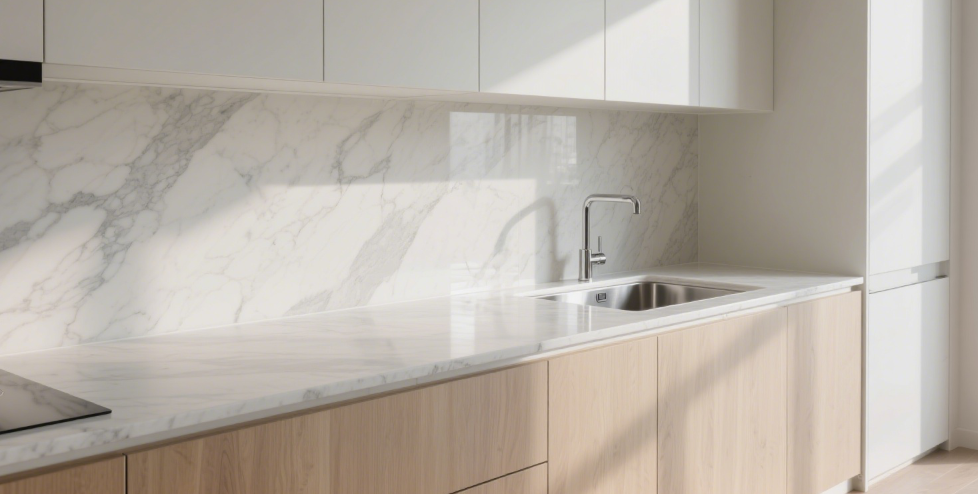
Why UV marble sheet fits cabinetry work
Kitchen and bath cabinetry requires surfaces that resist moisture, stains, heat to some degree, and daily wear. Using UV-coated sheets for cabinet panels, door faces, countertops (in low-heat use scenarios), and backsplash integrates a continuous marble-like look with lower cost and more predictable performance than many natural stones.
Cost-saving advantages in cabinetry
- Efficient panel-based production: Cabinet manufacturers working with sheet materials can optimize cutting, edge-banding, and lamination workflows to maximize yield.
- Reduced warranty costs: Surfaces resistant to staining and easy to clean lead to fewer service calls and replacements.
- Lower finishing costs: UV surface finishing often arrives fully cured and high-gloss from the factory, eliminating post-finish sanding or polishing on site.
- Standardization and modularization: Cabinets built from standard sheet sizes enable economies of scale in production and inventory.
Fabrication and installation considerations
- Edge treatment: For exposed edges, apply high-quality PVC or matching banding to maintain the marble look and protect against moisture ingress.
- Seam management: For countertops or long runs, seams can be minimized or joined with color-matched epoxy and polished to near-invisibility.
- Heat and use limits: While UV-coated sheets handle everyday kitchen use, they are not equivalent to high-heat stone surfaces; localized heat protection (trivets) is recommended.
- Adhesives and fasteners: Use adhesives and mechanical fasteners compatible with the substrate and face material to prevent delamination.
Production efficiencies to reduce costs
- Nesting software: Maximize material yield by nesting cabinet components efficiently prior to cutting.
- Batch processing: Group similar panels and finishes to reduce machine changeover times.
- Just-in-time supply: Coordinate supply with production schedule to minimize finished goods inventory and storage costs.
Design approaches that save money
- Use UV marble sheet as focal accents rather than full surfaces: Aesthetic impact can be achieved with limited panel use (backsplashes, island ends), controlling overall material quantity.
- Combine with cost-effective substrates: Use engineered cores such as plywood or MDF for internal structures and reserve the face for higher-value marble-look panels.
Use 3: UV Marble Sheet for Commercial Furniture and Fixtures — Fast Turnaround, Predictable Costs
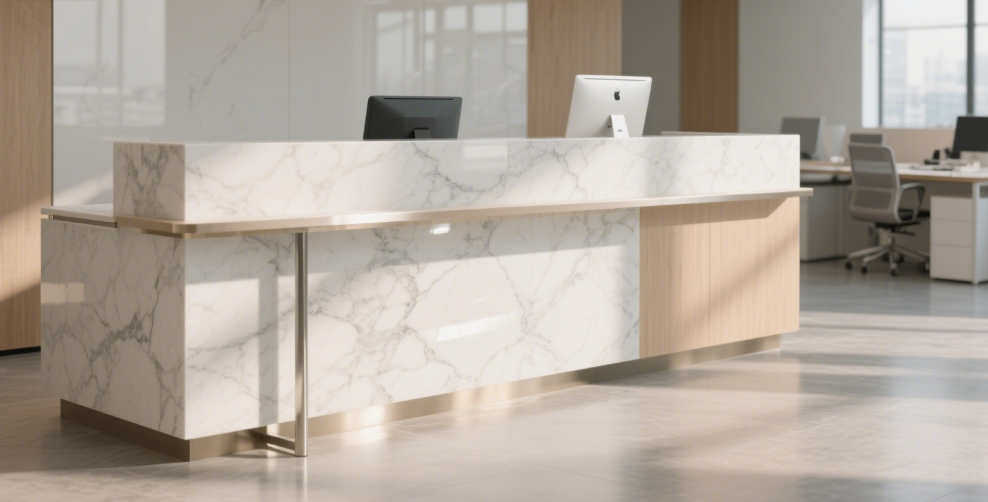
Opportunities in commercial environments
Retail stores, hospitality, corporate interiors, and public spaces often require durable, branded fixtures that present a premium look. UV marble sheet enables mass-customized furniture and fixtures that achieve a high-end appearance while controlling the bill of materials and fabrication timelines.
Where fixtures offer savings
- Prefabrication and modular assemblies: Store fixtures and reception desks can be produced off-site and installed rapidly, reducing on-site labor and occupancy downtime.
- Lower lifecycle replacement costs: The UV finish resists soiling and can be cleaned easily, extending service intervals.
- Repeatable quality for chain projects: For multi-site rollouts, consistent panel batches yield uniform appearance across locations.
Fabrication techniques for furniture
- Thermoforming and bending: Certain sheet compositions allow gentle bending for curved profiles—reduces the need for additional trim pieces.
- Integrated joinery: CNC routing and precision dowel/joiner systems produce tight-fit assemblies that reduce the need for face-frame construction labor.
- Embedded hardware planning: Design pre-routed channels for concealed fasteners to speed assembly.
Cost modeling for rollouts
When deploying the same fixture design across multiple locations, savings accrue through:
- Volume procurement discounts for sheet material.
- Streamlined production — fixtures move through identical CNC programs and finishing lines.
- Simplified installation — preassembled modules reduce on-site fit-out time.
A national or regional roll-out can reduce per-unit installed cost by 20–45% compared to locally fabricated custom stone-trimmed fixtures.
Use 4: UV Marble Sheet for Select Flooring Applications — Durable Visuals with Lower Upfront Cost
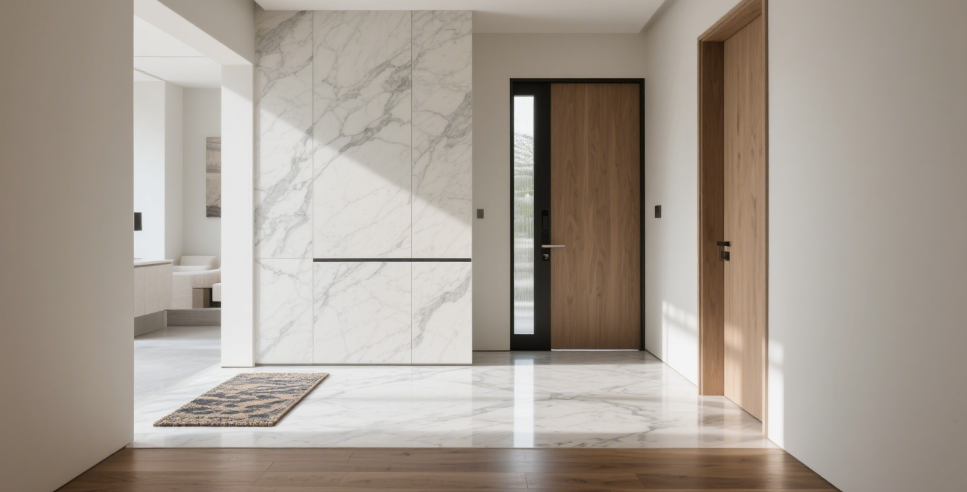
Applicability of sheet products to flooring
Not all UV-coated marble sheets are designed for high-wear flooring, but certain heavy-duty variants or composite systems are suitable for low to moderate traffic interior flooring, raised platforms, and temporary event floors. When material specifications match the intended wear class, using engineered marble-look sheets can be substantially less costly than natural stone.
Cost advantages in flooring
- Lower installation labor: Flooring sheets can be installed with fewer grout lines and less subfloor prep in some systems, lowering labor.
- Reduced material expenses: Engineered panels cost less per square meter than many stone tiles or slabs.
- Faster replacement and maintenance: Damaged sections can be replaced in patches without removing large areas of substrate.
Installation best practices for flooring
- Verify wear rating: Choose a grade of UV-finished panel rated for foot traffic and abrasion resistance.
- Subfloor preparation: Ensure the substrate is level, dry, and structurally adequate to prevent flexing that can crack panels or finishes.
- Joint and expansion planning: Include expansion joints to accommodate thermal movement and prevent buckling.
- Surface friction: For public spaces, verify the slip-resistance coefficient to meet safety codes.
Use cases for cost-efficient flooring
- Showrooms and retail islands where high aesthetic value is required but heavy industrial wear is absent.
- Temporary event spaces and pop-up stores where quick install/removal is necessary.
- Interior walkways in low-traffic sections of offices or boutique hotels.
Comparative Cost & Performance Snapshot
| Application Area | Typical Installed Cost vs Natural Marble | Labor Intensity | Durability (Typical) | Best for Savings If |
|---|---|---|---|---|
| Wall Cladding | 30–60% lower | Low–Medium | High for interior use | Design aligns to standard sheet sizes |
| Kitchen/Bath Cabinetry | 25–50% lower | Low | High (scratch & stain resistant) | Prefab cabinetry with mass production |
| Commercial Furniture & Fixtures | 20–45% lower | Low | Medium–High | Roll-outs and modular assemblies |
| Select Flooring | 20–50% lower | Low–Medium | Medium (choose rated panels) | Low to moderate foot traffic applications |
This table is a practical reference for procurement and design teams evaluating where to specify UV marble sheet. The ranges indicate comparative installed costs and typical performance expectations versus natural marble under common project scenarios.
Procurement and Sourcing Strategies to Maximize Savings
Standardize specifications early
Define panel sizes, finish types, edge profiles, and tolerance limits in early design phases. Standardized specs reduce custom fabrication and allow competitive bidding among suppliers.
Consolidate suppliers and volumes
Leverage project or company-level volume to negotiate better unit prices, favorable lead times, and priority scheduling.
Consider material mixes
Use premium engineered marble-look panels where visual impact matters and more economical materials where they don’t. This blended approach optimizes cost against perceived value.
Evaluate total cost of ownership (TCO)
Beyond purchase price, calculate installation labor, expected maintenance, replacement cycles, and disposal/recycling costs to choose the most economical option over the product lifecycle.
Require samples and small pilot runs
Before full-scale procurement, test samples and small pilot batches help validate color consistency, edge finishing, and installation methods—reducing risk of expensive rework.
Fabrication and On-Site Handling Guidelines
Protect edges and corners
Edges are vulnerable during handling. Use temporary edge guards, protective films, or pallet cradles during transport and on-site storage.
Maintain clean, controlled storage
Store panels flat, ideally in temperature-controlled spaces to avoid warping or UV exposure that can affect surface uniformity.
Train installers on adhesives and mechanical fasteners
Different substrates and adhesives require specific open times and curing behavior. Proper training reduces delamination and rework rates.
Use factory finishing where possible
Factory-applied edge banding and pre-drilled hardware locations reduce on-site machining and finishing labor, accelerating installation.
Maintenance Practices That Lower Long-Term Costs
Routine cleaning protocols
Mild detergents and soft cloths maintain finish and reduce wear. Avoid abrasive cleaners or harsh chemicals that can degrade the UV-cured surface.
Preventative inspections
Schedule periodic inspections to identify and replace small damaged panels before escalation. Quick local repairs cost less than widespread replacement.
Educate end-users
Provide simple care guides to clients and facility managers to reduce misuse and ensure the material’s lifespan is maximized.
Refinish vs replace decisions
Some surface damages can be corrected with targeted refinishing products or patch kits. Establish thresholds for when to refinish versus replace to control lifecycle costs.
Sustainability and End-of-Life Considerations
Recycling and material recovery
Some engineered panels can be recycled or down-cycled into composite fills. Work with suppliers who offer take-back or recycling schemes to reduce disposal costs and environmental impact.
Lower embodied carbon vs quarried stone
Manufacturing and transporting heavy stone contributes to lifecycle carbon. Lightweight sheets often require less transport energy and allow reduced structural mass, which can lower overall embodied carbon for a building.
Certifications and compliance
For projects seeking green building credits, request EPDs (Environmental Product Declarations), low-VOC certifications, and relevant health and safety data from suppliers.
Case Studies: Real-World Savings Examples
Case Study A: Boutique Hotel Lobby Cladding
A boutique hotel replaced planned natural marble for its lobby walls with UV-coated panels. Savings came from:
- 45% lower material and transport costs.
- 35% faster installation time, opening the lobby earlier.
- Reduced need for reinforced framing, saving structural steel costs.
Overall project savings enabled a higher-quality lighting package within the same budget.
Case Study B: Chain Retail Roll-Out
A retail chain used UV marble sheet for checkout counters across 50 stores:
- Centralized fabrication reduced unit cost through volume discounts.
- Preassembled modules reduced in-store installation to a few hours per site.
- Consistent finish across stores improved brand perception while lowering total fit-out cost by approximately 30%.
Case Study C: High-End Residential Renovation
A developer used UV marble sheet for kitchen cabinetry and backsplash:
- Achieved marble look with lower materials cost.
- Faster turnaround reduced show-home preparation time and improved sales velocity.
- Simplified maintenance notes increased buyer confidence and lowered post-sale support calls.
Implementation Roadmap for Project Teams

- Feasibility study: Evaluate where UV marble sheet fits design intent and performance needs.
- Specification development: Set material grades, edge treatments, and fire/safety requirements.
- Supplier pre-qualification: Review certifications, lead times, and sample quality.
- Pilot fabrication: Produce a mock-up panel or run to confirm color, seams, and edge finishing.
- Full procurement: Consolidate orders and set delivery schedules aligned with installation.
- Installer training: Provide instruction on adhesives, fasteners, and protection measures.
- Post-install inspection: Verify final finish, seam integrity, and handover maintenance documentation.
Common Pitfalls and How to Avoid Them
- Over-specifying material: Don’t default to the most premium grade if project use does not demand it. Match specification to functional need.
- Ignoring fire codes: Always confirm local fire ratings for interior finishes; add barriers if needed.
- Poor seam planning: Uncoordinated seams lead to visible misalignments—pre-plan panel sequences.
- Inadequate storage: Panels must be stored flat and protected; onsite mishandling leads to costly damage.
- Underestimating edge finishing: Exposed edges define perceived quality—invest in proper edge banding or profiles.
Conclusion
Selecting material solutions that balance aesthetics, performance, and cost is a key strategic decision for B2B buyers and project teams. UV marble sheet delivers an attractive alternative to natural stone in many building applications—especially interior wall cladding, cabinetry, commercial fixtures, and selective flooring—where it can save significant money without compromising on visual impact. Savings arise from lower material costs, reduced structural requirements, faster installation, and lower lifecycle maintenance. By standardizing specifications, optimizing fabrication and installation workflows, and choosing the right panel grade for each use case, project teams can harness both design and budgetary benefits.
When considering this material, perform small-scale pilots, secure clear supplier warranties, and include installation training to achieve the best long-term outcomes. Properly executed, UV marble sheet becomes a powerful tool in the procurement and design toolbox: a way to deliver marble aesthetics while controlling cost, time, and operational complexity.
FAQ
Q1: Are UV marble sheet panels suitable for exterior use?
A1: Some variants are designed for sheltered exterior applications, but many are optimized for interior use only. Always confirm UV resistance, weather rating, and fire classification from the manufacturer before specifying for exterior cladding.
Q2: How does the cost of UV marble sheet compare to natural marble?
A2: Installed cost for UV-coated panels typically ranges 20–60% lower than natural stone, depending on complexity, access, and finish requirements. Savings are influenced by transport, substrate, and labor considerations.
Q3: Can UV marble sheet be used for countertops?
A3: Yes, for light to moderate use countertops and vanities. For heavy-duty heat or cutting tasks, use protective surfaces or higher-performance engineered stone alternatives.
Q4: How do I ensure color consistency between production batches?
A4: Order full project quantities when possible, request batch color certificates, and perform on-site sample approvals. If multiple batches are unavoidable, mix panels from different batches across areas to minimize visible variation.
Q5: What is the typical lifespan of a UV-finished panel in indoor applications?
A5: With proper maintenance, indoor UV-finished panels can last 10–20 years or longer; lifespan depends on wear, cleaning regimens, and impact exposure.
Q6: Are UV marble sheets recyclable?
A6: Some manufacturers offer recycling programs, and panels may be down-cycled into fillers or reclaimed for composite use. Confirm recycling options and policies with suppliers.
Q7: How do adhesives and sealants affect longevity?
A7: Using recommended adhesives and proper curing greatly influences bond strength and longevity. Avoid incompatible adhesives that can cause discoloration or delamination.
Q8: Can seams be made invisible?
A8: Tight fabrication tolerances, color-matched epoxy, and precise installation techniques can make seams minimally visible, though perfectly seamless results are rare for long runs.
Q9: Do UV coatings fade over time?
A9: High-quality UV-cured coatings are designed for color fastness, but prolonged exposure to direct sunlight may cause gradual changes. Specify UV-stable formulations for areas with high sun exposure.
Q10: What maintenance is required for high-traffic installations?
A10: Routine cleaning with mild, non-abrasive cleaners, regular inspections for surface wear, and periodic localized repairs prevent small issues from escalating.
Let’s Keep in Touch! 🌟

Thanks for reading—I’m glad you joined me on this journey!
If you found this content valuable, insightful, or thought-provoking, I’d love to hear your thoughts.
📘 Follow me on Facebook for exclusive tips, behind-the-scenes insights, and community discussions.
👉 Click here to connect
Feel free to share your feedback or questions in the comments or on social media—I’m always here to chat.
Let’s keep exploring, learning, and growing—together! 🚀😊
